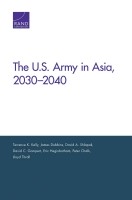| 来源类型 | Research Reports
|
| 规范类型 | 报告
|
| ISBN | 9780833083937
|
| 来源ID | RR-474-A
|
| The U.S. Army in Asia, 2030-2040 |
| Terrence Kelly; James Dobbins; David A. Shlapak; David C. Gompert; Eric Heginbotham; Peter Chalk; Lloyd Thrall
|
| 发表日期 | 2014
|
| 出版年 | 2014
|
| 页码 | 174
|
| 语种 | 英语
|
| 结论 |
The U.S.-China Relationship Will Be the Fulcrum for U.S. Policy in East Asia- The United States needs a strategy that recognizes shared interests with China at the global level, the real potential for friction in the Western Pacific, and the challenge of balancing the two. Developing such a strategy will be more difficult in practice than in theory.
- U.S. military strategy will need to be flexible and resilient given China's increased capabilities, which will place significant demands on the U.S. Army.
- Robust military-to-military relations between the United States and China will be a necessary part of the overall U.S. effort to improve understanding and increase transparency. The Army will play an important part in these arrangements.
The Army Will Play Critical Roles in Supporting U.S. Strategy in the Asia-Pacific Region- The Army will be committed to a wide range of partnership-building activities with friends and allies in the region.
- The Army will be responsible for conducting and supporting joint military operations, which may place significantly greater demands on its combat support and combat service support forces than have recent conflicts.
- The Army will need to explore ways of expanding its role in countering Chinese anti-access/area-denial capabilities.
|
| 摘要 |
- U.S. regional engagement strategies should not view China as an enemy. Rather, they should seek to develop ways to promote cooperation and reduce tensions.
- U.S. military strategy will need to be flexible and resilient given China's increased capabilities, which will place significant demands on the Army. It should reflect China's national strategy and endeavor to keep China on a path consistent with international norms in which the incentives for cooperation remain high.
- The U.S. Army should work to enhance military-to-military engagements between the United States and China and between the United States and regional partners. It should also focus on building partner capacity to ensure that regional forces can play a more active role in deterring possible Chinese aggression.
- The Army should be prepared to conduct and support joint military operations, which may place significantly greater demands on its combat support and combat service support forces than have recent conflicts.
- The Army should work to enhance its capabilities by training to operate under conditions of degraded communication and other capabilities resulting from Chinese anti-satellite, cyber, and other attacks. Similarly, it will need to foster anti-access/area-denial capabilities to counter Chinese force projection. It should also consider fielding a capability to reach targets in China to deter and degrade Chinese anti-access/area-denial capabilities, if treaty obligations permit it.
|
| 主题 | China
; Military Force Planning
; Military Strategy
; Threat Assessment
; United States
; United States Army
|
| URL | https://www.rand.org/pubs/research_reports/RR474.html
|
| 来源智库 | RAND Corporation (United States)
|
| 资源类型 | 智库出版物
|
| 条目标识符 | http://119.78.100.153/handle/2XGU8XDN/107829
|
推荐引用方式
GB/T 7714 |
Terrence Kelly,James Dobbins,David A. Shlapak,et al. The U.S. Army in Asia, 2030-2040. 2014.
|
|
文件名:
|
x1495316368481.jpg
|
|
格式:
|
JPEG
|

|
文件名:
|
RAND_RR474.pdf
|
|
格式:
|
Adobe PDF
|
除非特别说明,本系统中所有内容都受版权保护,并保留所有权利。